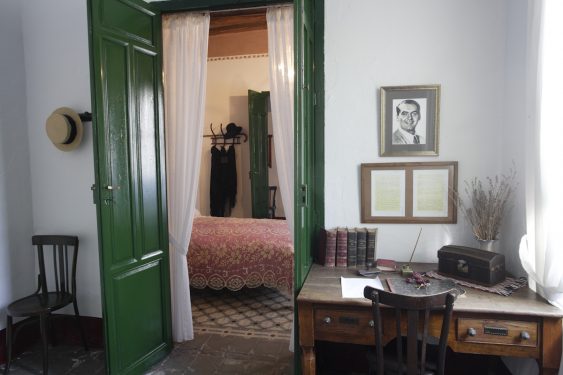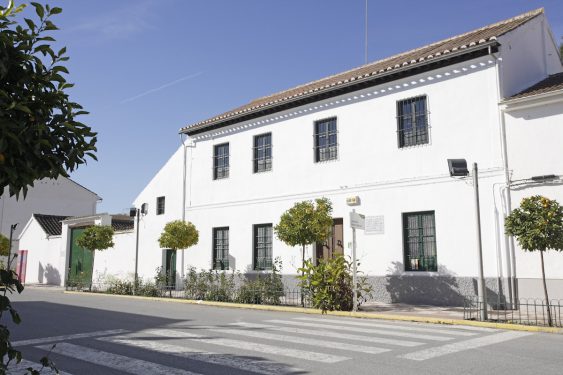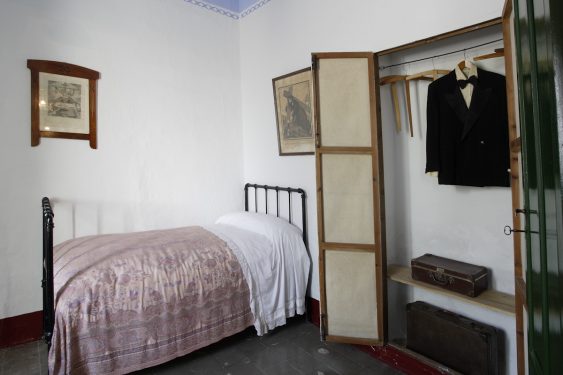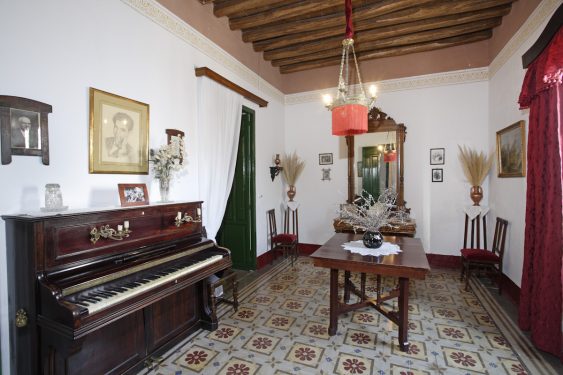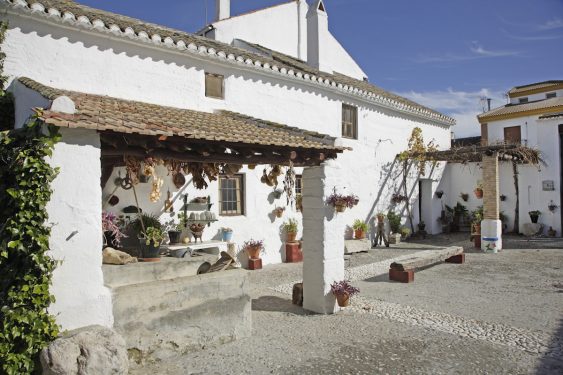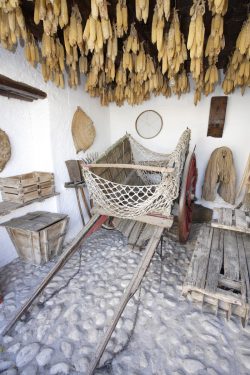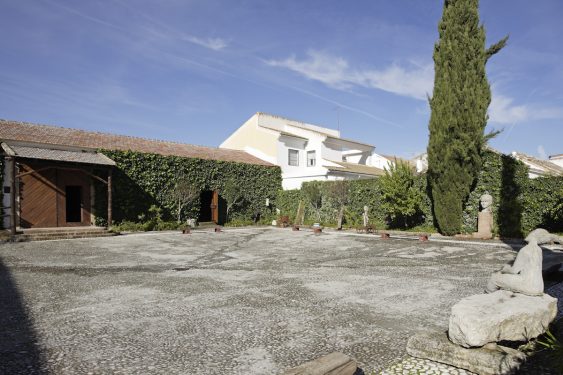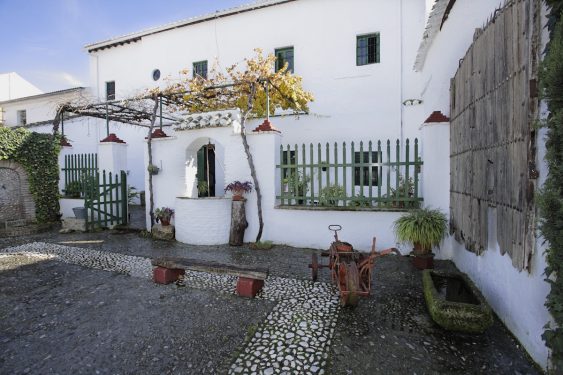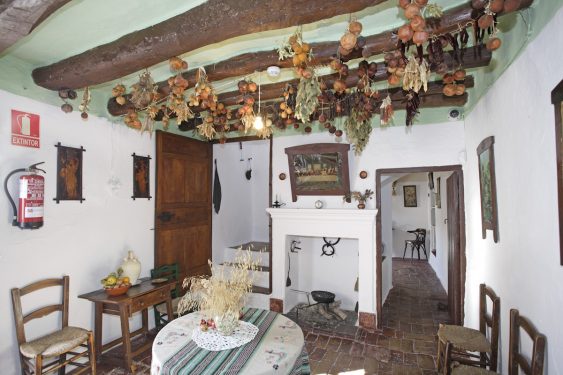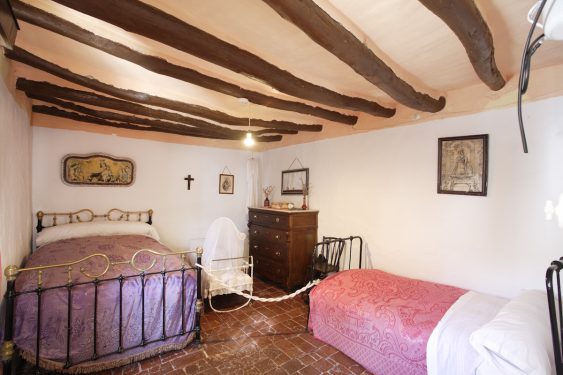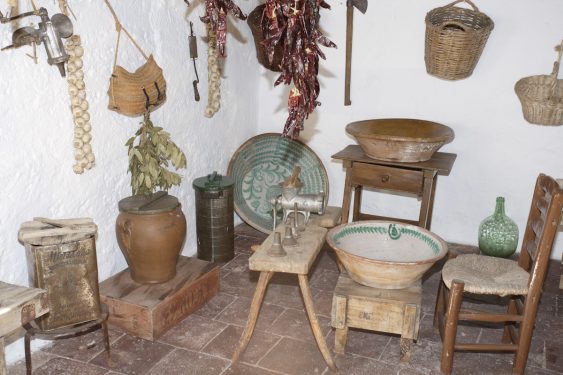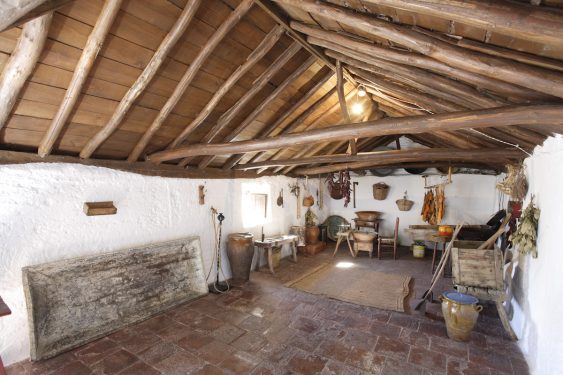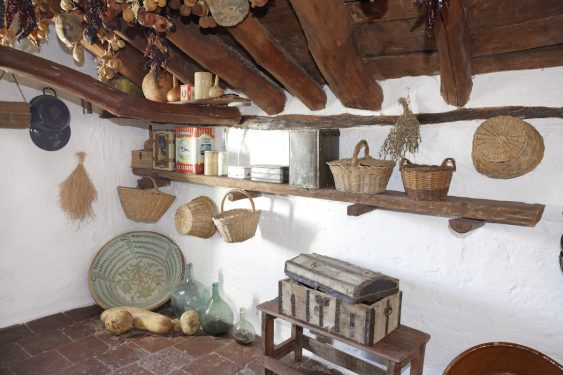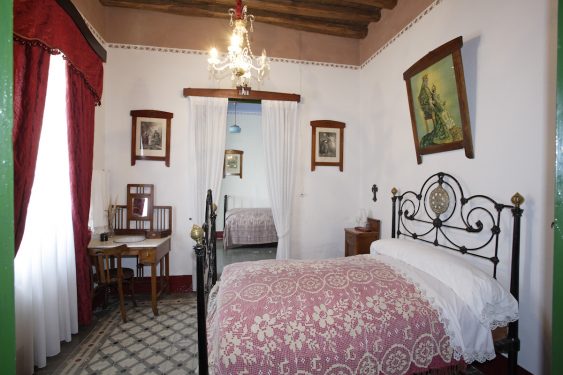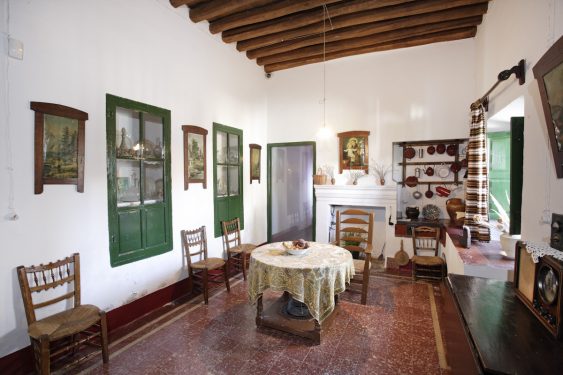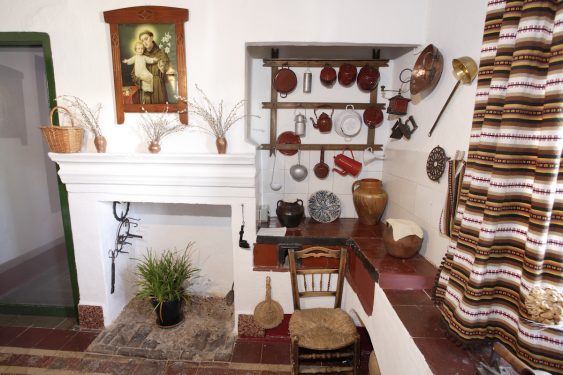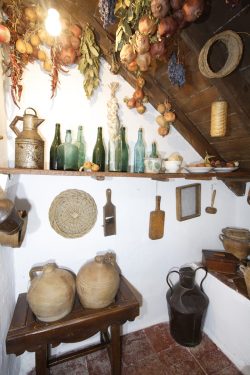The Lorca family moved to Valderrubio in 1906, to a house on Iglesia street, which has been converted into a museum. After the move to Granada it was their summer home until 1925.
The García Lorca family moved from Fuente Vaqueros, the village where three of the couple’s children were born (Federico, Francisco and Concha; Isabel would come into the world in Granada in 1909) to Asquerosa (Disgusting) in 1906. They first lived, for a short time, in a house in Ancha Street, next to the parish church, but later moved to a large farmhouse located at 20 Iglesia Street, which became their permanent home until 1908 and then, until 1926, their summer residence. The current House Museum of the poet is a faithful recreation of both the container and the content of the original. To the house has been attached the house of the landlords, a kind of rural museum of the early twentieth century.
The decisive cause of the move from one town to another was of a practical nature: the father of the family, Federico García Rodríguez, had concentrated much of his agricultural business as well as his most valuable assets, in this small village near Fuente Vaqueros of a few hundred inhabitants, an authentic orchard with an unfortunate name resulting from the defective derivation of its authentic and delicate denomination: Aguarosa or Acuerosa (i.e., of abundant waters). Prosperity had come thanks to the purchase, in 1895, of the Daimuz Bajo farmhouse and estate, which included numerous lands that later extended to the Vega de Zujaira, the place where Federico signed many of his youthful poems.
The family’s move to Granada did not interrupt Federico’s relationship with Asquerosa (Disgusting). Every year, when the Corpus Christi festivities ended in Granada, they migrated to the house in Valderrubio where they spent the summer coinciding with the agricultural work.
Although Federico had been born in Fuente Vaqueros eight years earlier, the fundamental experiences of his childhood and adolescence came to life in Asquerosa (Disgusting). There, among poplar groves, sources and rivers, had his “first artistic astonishment”, trained as a musician, groped in literature and wrote the compositions that made up the Book of Poems, Songs and Suites. La Vega’s influence, however, was deeper and more lasting and would appear more or less explicit in Divan del Tamarit. Valderrubio would inspire one of his last plays, The House of Bernarda Alba, based largely on authentic events and characters, which sparked some family clashes, and some scenes from Yerma and Blood Wedding.
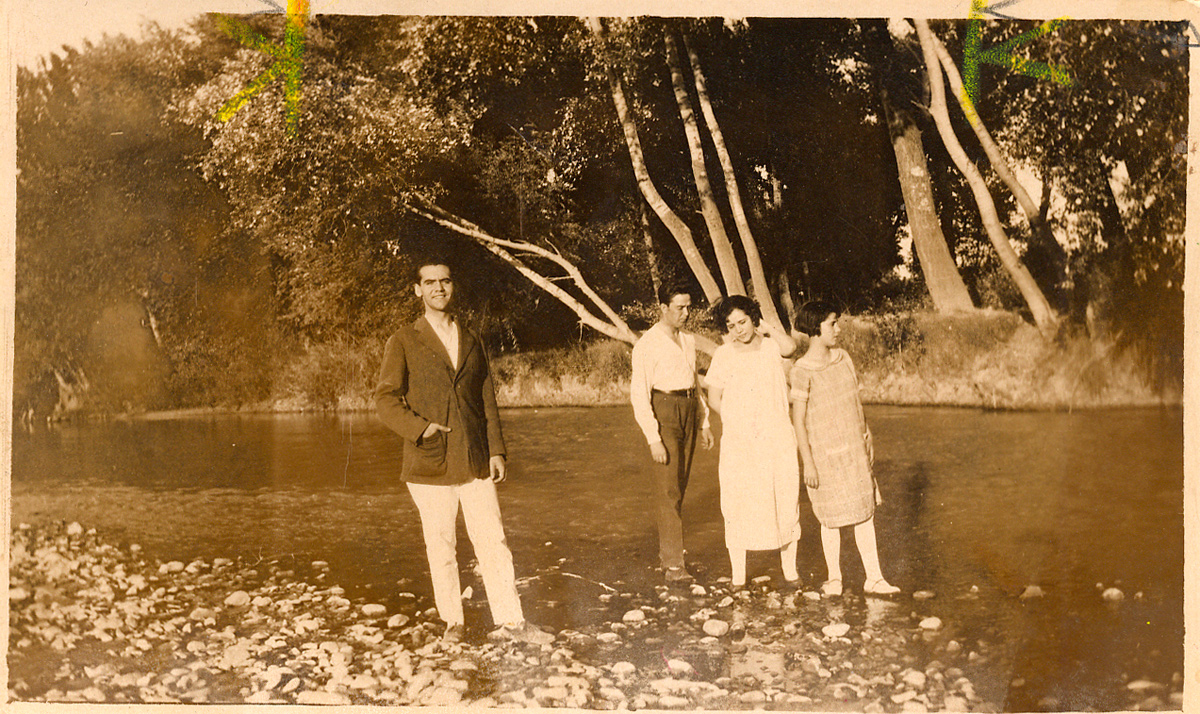
Asquerosa (Disgusting), or Valderrubio, was a very important flow in Lorca’s work and, as a whole, in the poet’s attitude in life: “My most distant memories as a child have a taste of land. The earth, the countryside, have done great things in my life. The bugs of the earth, the animals, the peasant people, have suggestions that reach very few. I capture them now with the same spirit of my childhood years,” he confessed in March 1934 to journalist José R. Luna, who interviewed him for the Crítica magazine of Buenos Aires.
The family’s move to Granada in 1908 did not interrupt Federico and his brothers’ relationship with Asquerosa (DIsgusting). Every year, when the Corpus Christi festivities ended in Granada, the family emigrated to the house in Valderrubio where they spent the summer, coinciding with the agricultural work. The seasonal stays were maintained until 1926 when they acquired the Huerta de San Vicente (San Vicente Farmhouse) in Granada.
After a brief stay in Ancha Street, the Lorca family moved to a house that was “large, full of nooks and crannies, with a high step at the entrance” located at Iglesia, 20. According to the memory of Isabel García Lorca the house was “ramshackle, with a patio that separated it from the immense corrals and stables: with a brick bench, a wooden gate painted green, many pots of geraniums and Dom Pedro tulipss, a vine and a huge red oleander”. All the rooms were whitewashed and the ceiling was a deep blue except Federico’s, which was painted violet. The walls were decorated with lithographs of Nordic countries. Those foreign and incongruous landscapes competed on the house walls with a large print of the Christ of the Cloth of Moclín that none of the siblings forgot. Lorca even incorporated the pilgrimage into the final scene of Yerma.
The celebration of Saint Federico was the excuse for large family reunions in Asquerosa (Disgusting) attended by more than forty first cousins, plus their spouses, children, the mothers of the newborns and the chauffeurs who brought them to and from Asquerosa (Disgusting).
The Lorca’s relationship with some neighbors and relatives of Valderrubio was full of misunderstandings and braided by envy and hatred. Disputes over the boundaries of the estates and other controversies clouded the relationship.
Isabel García Lorca has emphasized the singular influence that the games and nursery rhymes heard in Asquerosa (DisgustIng) had on her brother’s early work. In Federico, she writes, the couplets appear as “songs fused in a feeling that he relives in a present that is no longer that of his childhood, enlivening a memory that he now sees as different from the past.” Thus chorus songs like “ there goes my sparrowhawk / with four cat’s claws / If you don’t bring me meat, / I’ll kill you”, are transformed in the poem Sad Ballad into [“as a child I sang like you,] / niños buenos del prado, [good children of the meadow,] / niños buenos del prado, [I released my sparrowhawk with the fearsome] / cuatro uñas de gato” [four cat’s claws”]. Or poems that incorporate part of popular romances, such as the one about Count Laurel: cuatro uñas de gato” [“-Why do you wear a shawl] / cuatro uñas de gato” [black with death?] / -¡Ay!, yo soy la viudita, [- Oh, I am the widow,] / -¡Ay!, yo soy la viudita [sad and without goods,] / -¡Ay!, yo soy la viudita [of the Count of Laurel] / -¡Ay!, yo soy la viudita [of the Laurels”] (Ballad of a Day in July, 1919).
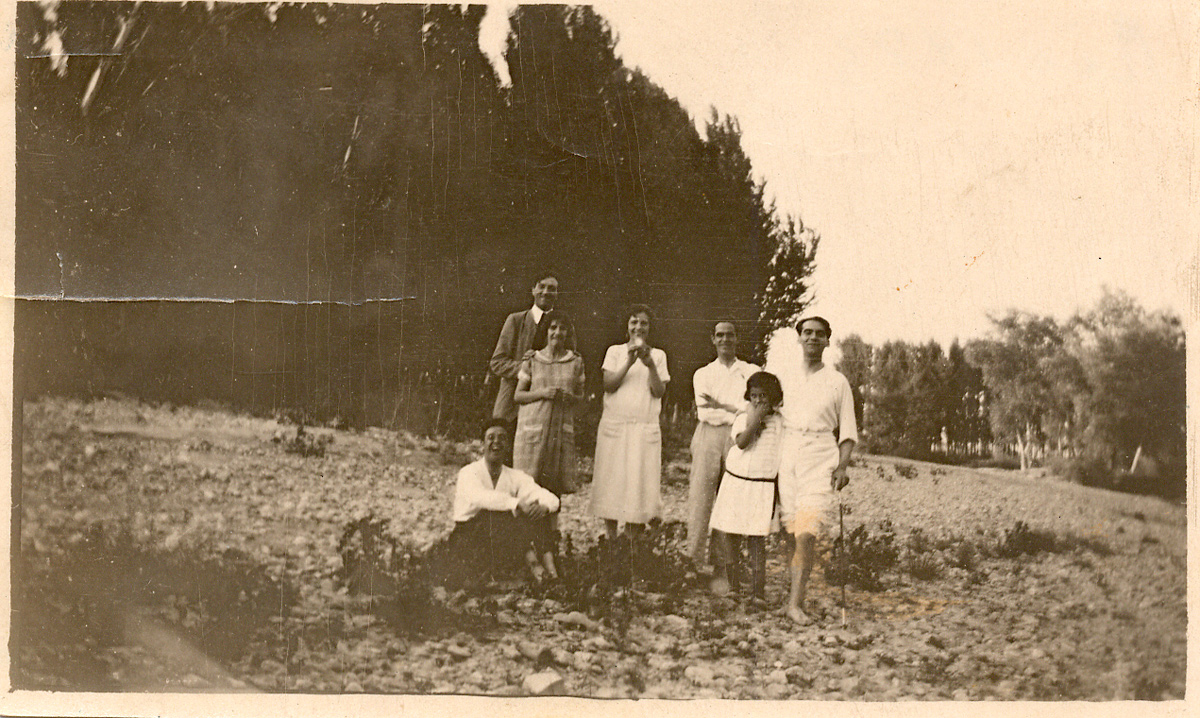
The relationship of the Lorca’s with some neighbors and relatives of Valderrubio was full of misunderstandings and braided by envy and hatred. Disputes over the boundaries of the estates and other controversies clouded the relationship with the family of Horacio Roldán, cousin of the poet and active right-wing militant. Those disputes, after the uprising, turned into persecution. According to the investigator Miguel Caballero, the brothers Miguel and Horacio Roldán participated in two of the groups that broke into the Huerta de San Vicente in August 1936, on the days before the murder of the poet. They were accompanied by José Benavides Peña, Pepe el Romano from The House of Bernarda Alba. One of the individuals who participated in Lorca’s detention at the home of the Rosales family was Juan Luis Trescastro, whose wife was a cousin of the poet. Also on the firing squad was Antonio Benavides Benavides, Trescastro’s buddy, cousin of the Roldán family and grandnephew of Matilde Palacios, the first wife of Lorca’s father, who died prematurely. The House of Bernarda Alba, inspired by the life of Frasquita Alba, also raised strong misgivings as it incorporated the real names of some neighbors in Valderrubio.
In a letter written to the music critic Adolfo Salazar from Asquerosa (Disgusting), Lorca makes a beautiful description of summer evenings in the countryside: “Days gone by a greenish-purple moon rose over the blue haze of the Sierra Nevada, and in front of my door a woman sang a berceuse that was like a golden serpentine that entangled the whole landscape. Above all, in the evenings one lives in full fantasy, in a half-erased dream… there are times when everything evaporates and we are left in a desert of pearl gray, rose and dead silver. I can’t tell you how huge this valley is or this little white village among the dark poplar trees. At night our flesh aches from so much starlight and we get drunk on breeze and water”.
The lyrical expectation of the summers sometimes became a headache. In July 1926, Federico confesses to his brother: “I am tired of this. Asquerosa (Disgusting) is not really the countryside. It’s all full of stupid etiquette, you have to greet people and say good night. You can’t go out in your pajamas because they’ll throw stones at you and it’s all full of clumsy malice and bad intentions. In the countryside you look for innocence. I put all this down to the fact that there are no cows or grazing of any kind here”.
José Mora Guarnido attributes the name Asquerosa (Disgusting) to an error in pronunciation, which was perpetuated, and defends the cultured and cheerful character of the inhabitants of the village. “I believe that when this small village was inaugurated, born around a house of the administrators and perhaps also of the church, when trying to personalize it with a name, some little inkpot of the English administration or splat charge of the civil intervention wanted to show off his erudite initiative and innocently proposed the name of Acuerosa or Aguarosa (abundant in water) simply because the land, where the Genil and two of its quiet tributaries, the Cubillas and Velillos, meet, is full of subway current (…). But they did not count on the degeneration that popular Andalusian phonetics would immediately impose on a word as delicate as it was ambitious. People began to say Asquerosa and the name, with more than cruel docility, was accepted”.
An unfortunate and sad fact, alleges Mora, which contrasts with the curious and educated personality of the inhabitants of Valderrubio. “Its inhabitants were mostly educated and sensitive. Peasants who, on arriving home after the day’s work, sat down to read or play the piano; people who accompanied those peseta books, bad translations, mainly of anarchist literature, that poured over the thirst for knowledge of the humble people of Spain”. Reading was shared with music and it was not uncommon for “those rough men” to interpret Chopin. “I have never seen in Spain a people of such curious and fine preparation”.
The differences between Fuente Vaqueros and Valderrubio can be seen among the dissimilarities of some of Lorca’s works. According to Francisco García Lorca, Fuente Vaqueros represented the happy atmosphere of The Shoemaker’s Prodigious Wife, while Valderrubio was The House of Bernarda Alba. For her part, Isabel maintains in her memoirs that Asquerosa (Disgusting) was not “open and cheerful like Fuente Vaqueros, which is in full greenery between two rivers; it is more taciturn, more closed, as are the villages of the drylands (…). That is reflected very well in Blood Wedding“.
La Vega de Zujaira was one of Federico’s favorite places to retire in search of contact with nature and inspiration for his poems. Numerous compositions of his youth, especially from 1920, are dated in that place of flexible contours and name with Arabic reminiscences: Summer Madrigal (1920), New Songs (August 1920), The Premonition (August 1920), Prolog (July 24, 1920), Interior Ballad (July 16, 1920) or The Old Lizard (1920).
It is possible that the Vega de Zujaira was, for Lorca, a euphonic term that spared him the use of the coarse toponym of Asquerosa (Disgusting). From a cadastral point of view, it comprised an estate that was part of the payment for the Vega de Zujaira, near Asquerosa (Disgusting).
There Federico García Rodríguez built a farmhouse, nowadays non-existent, called de la Gariba or de la Cuesta de Ajea, where the caretaker and his family lived. Federico became friends with them and used to visit them frequently to soak up the legends that the family’s grandmother told him. The farm bordered a small railroad station, the San Pascual halt, integrated in the Granada-Bobadilla line, from where the railbus that linked Casanueva with Granada departed. The halt was located near the San Pascual sugar beet factory, of which the poet’s father was a partner.
Among the characters that the Lorca family dealt with assiduously in Valderrubio, the most prominent is the “relative Ricardo”, an employee of Don Federico in the workshops of the San Pascual factory with a tendency to be a poet. The Lorcas used to go to his house. Ricardo played the piano by ear and accompanied his daughters in choral songs that he himself composed. He felt a great admiration for Federico and the latter reciprocated by chanting his songs with pleasure.
Dulce chopo,
[Sweet poplar,]
Dulce chopo,
[sweet poplar,]
Te has puesto
[you’ve started]
De oro.
[turning yellow.]
Ayer estabas verde,
[Yesterday you were green]
Un verde loco
[a crazy green]
De pájaros
[of magnificent]
Gloriosos.
[birds.]
Hoy estás abatido
[Today you’re depressed]
Bajo el cielo de agosto
[under the August sky]
Como yo frente al cielo
[same as me looking at the stars]
De mi espíritu rojo.
[with my red spirit.]
La fragancia cautiva
[The fascinating scent]
De tu tronco
[of your trunk]
Vendrá a mi corazón
[will reach my pious]
Piadoso.
[heart.]
¡Rudo abuelo del prado!
[Hey, tough grandfather of the flat land!]
Nosotros,
[We too,]
Nos hemos puesto
[have started]
De oro.
[to turn yellow …]
- Miguel Caballero. The Last Thirteen Hours in the Life of García Lorca. La Esfera de los Libros. Madrid, 2011.
- Miguel Caballero and Pilar Góngora Ayala. The Truth about the Murder of García Lorca. Ibersaf. Madrid, 2007
- Federico García Lorca. Poems of La Vega. Selection by Javier Alonso Magaz, Luis García Montero and Andrea Villarrubia. Galaxia Gutenberg. Barcelona, 2014.
- Federico García Lorca. Word of Lorca. Full Statements and Interviews. Edited by Rafael Inglada and Víctor Fernández.
- Francisco García Lorca. Federico and his World. Alianza Tres. Madrid, 1990.
- Isabel García Lorca. My Memories. Tusquest. Barcelona, 2002.
- Ian Gibson. In Granada, his Granada. Plaza y Janés, Barcelona, 1989.
- Ian Gibson. From Fuente Vaqueros to New York. Biography. Grijalbo. Barcelona, 1985.
- José Mora Guarnido. Federico García Lorca and his World. Losada. Buenos Aires, 1958.
- Lorca´s location
- Lorca’s family home in Valderrubio
- current location
- House Museum of Federico García Lorca in Valderrubio
- ADDRESS
- Iglesia, 20
- Web
- http://www.valderrubioenlorca.com/
- Telephone
- 958 454 217
- reservas@valderrubioenlorca.com
- DETAILS OF THE VISIT
The visit to the house must be arranged by appointment. Please, check its website for opening dates.
